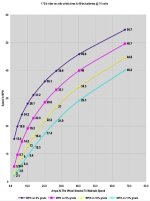xyster
10 MW
Finding it quite helpful while planning my EV, I originally posted the graph below at the Old V. The variables are calculated from the bicycle speed and power calculator here:
http://www.kreuzotter.de/english/espeed.htm
All I did was dump to Excel the calculator's output for power requirements at different speeds and inclines for a standard MTB rider carrying extra weight, dividing by 74 volts to get the amps needed at the wheel (meaning after subtracting efficiency losses).
I've found excellent agreement between this graph's predictions, and real-life results for my system.
http://www.kreuzotter.de/english/espeed.htm
All I did was dump to Excel the calculator's output for power requirements at different speeds and inclines for a standard MTB rider carrying extra weight, dividing by 74 volts to get the amps needed at the wheel (meaning after subtracting efficiency losses).
I've found excellent agreement between this graph's predictions, and real-life results for my system.


